Thursday, November 23, 2006
Tuesday, November 07, 2006
Monday, November 06, 2006
Sunday, November 05, 2006
Thursday, November 02, 2006


Native Pride marches up the Hillside to dispell myth of Columbus
Captions: Left to right are: Jon Perrin, Savannah Howes, Ronny Powell, Alesia Buffalo, and Courtney Cochran.
Jackie Fairbanks, a 6th grader at Woodland Middle School walked beside her father, John Fairbanks. She said, “We aren’t really celebrating the truth.” She thinks Native Americans are treated differently when the truth is not taught.
Last month on Columbus Day while the city hall, and downtown Post Office stood quiet because employees had this legal holiday off, a chant could be heard: “Say it loud! Say it proud! Native pride marching up the Hillside!” The chant was shouted by Native American youth.
It was Mon., Oct. 9. A group of teenagers named Native Youth Agenda led over 144 people on a one-mile march from the library on the corner of Fifth Avenue West and Superior Street to the Washington Center on North Lake Street and Third Street West.
Jackie Fairbanks, a 6th grader at Woodland Middle School walked beside her father, John Fairbanks. She held a sign that said, “Myths of Columbus: He found and discovered America; He is a national hero.” She said she was walking because it was good for native people to get together, “We aren’t really celebrating the truth,” she said of Columbus Day. “We are sort of living a lie.” She also said that when most of America celebrates Columbus Day, “They treat us differently.”
Jon Perrin, a 9th grader at Denfeld, High School said, “We just believe that Columbus did not actually find land. He traveled and discovered (America) and killed natives.
Dana Megenupch said she participated in the march “…to support my people.” She went on to say, “(They) tired to banish us. We need to make people realize that we were here first and to stop trying to demolish us. It will never be done.” As the crowd walked by the Washington Center on Fourth Street she called out to some teenage boys across the street telling them they ought to join their people.
Once inside the Washington Center a large crowd gathered to prepare for a meal. Duluth Mayor Herb Bergson spoke to the group. “This is the last time the City of Duluth will allow a day off for Columbus Day,” he said. Bergson said he was raised to celebrate Columbus Day, but while in college he learned the truth about Columbus. We raised our two sons to know the truth he said, “The man was a slave trader and a butcher, and we can not honor murderers.” He said the whites and black in the room were there to show their support.
After Bergson’s speech the crowd listened to the Lake Vermillion Singers. Bill Howes, a leader with Native Youth Agenda said it was an honor song for “Every single person who lost their life fighting for something they believed in.”
Before the meal, Virgil Sohm said a prayer in his native tongue. The youth served the elders before they themselves could eat.
Bill Howes was one of the adults working with the youth. His wife Edye Howes is the coordinator of Native Youth Agenda and they have a daughter, Savannah, age 13, in Native Youth Agenda. (They also have a daughter Che, age 5) He said the young people choose this issue a couple of years ago and the youth had set a goal of having 250 people show up. By time the event ended with a meal there were 250 people.
Howes said, “It is about the youth standing up and doing something that they thought was important.” He went on to say, “The goal is more than just the march. It is to keep spreading the message. Ultimately, it is important to learn the truth. There are all kinds of events we need to look at from multiple perspectives, not just one person who gets to write the textbook
Rachel Kincaid works with youth every day. She is the executive director of Lifehouse. She said it was good for the youth to learn how to lead an event like they did for the Myth of Columbus Day. “It allows them to know their own strength and power to change things,” she said.
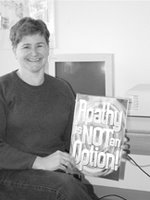

The Buzz
Captions: Judy Phifer above and Chad Behling at left.
Rockbochs, Inc moved to 202 E. Superior St. in February 2006. Chad Behling is the owner. He does technology consulting to businesses. Clients include a natural disaster communication company and Maurice’s.
Rev. Warren Schulz will be the interim pastor at First Lutheran Church at 1100 E. Superior St. He will start on Nov. 15 and serve until a permanent senior pastor is found which will be approximately one year.
Former Senior Pastor Rick Lund is now serving an ELCA church in Madison, Wis.
Duluth First Oriental Grocery store moved at the end of September. They are in the old Dogbooties.com location. The new address is 801 E. First St. They now have parking and air conditioning
Precious Lord’s Ministry will be opening up at 101 W. Fourth St. Jackie Palm, her family and friends are remodeling the old store to open a ministry to people involved in drugs, crime and prostitution. Palm said, “There is something better than what you are doing. You can have a positive life and higher self-esteem.” She said this ministry would provide them with people who care.
Needed donations at this time for Precious Lord’s Ministry includes a piano and design work. The ministry hopes to open in November. For more information phone 218-428-9268.
Have a digital camera? Send photos of garbage violations to sbenning@ci.duluth.mn.us or phone Sarah Benning, solid waste administrator at 218-730-5151
George Garnett, Executive Director of Neighborhood Housing Services of Duluth, will speak at the next police-sponsored community meeting on Tue., Nov. 14, at 7:00 p.m. at the Central Hillside Community Club building. George will speak on NHS’s efforts in the Lincoln Park neighborhood to fight crime and improve housing and vacant lots through code enforcement. George will speak about joint efforts between residents, neighborhood agencies, and city departments, including block club anti-crime efforts



I’ll put it plainly: our Duluth Hillside doesn’t contain enough businesses owned by those that contribute to these richly diverse neighborhoods, namely people of color.
How sad it is to say goodbye to a business with great potential in the Duluth Hillside, “Diamonds in the Rough” and owner, Melissa Grimes. Your September article points out cause for sadness very well: strained economics and a lost connectedness for our neighbors of color.
Ownership, whether a business, home or possession, a way of life, education, an idea, heritage, or talent, (the list is endless), is part of what makes us who we are. And I’m not leaving out passion, in this case defined as commitment, enthusiasm, zeal, or drive. This passion led a woman of color, Melissa Grimes, to open a business in Duluth for which there is a market and need.
Duluth, more specifically our Hillside, has people of passion, people responding to potential and possibilities. Passion and dreams are just as real and legitimate as the need for food, and likewise the need for connectedness and ownership.
I believe in possibilities. I may not have the same talents, passions (or dreams) as my neighbor, but I believe that possibilities abound for those wanting to live out their talent, their passion: this includes any person of color.
Sorely lacking are the tools to accomplish this: money, education, and not the least of which are support and encouragement from the community at large.
A small business, a locally owned business, is vital to any community of any size or cultural character. We tell our young people that they can be whatever they want to be. Yet do we really show them a way, help them follow through on a dream, a passion?
Deyona and Jamar Kirk have responded. Their ownership of Ma and Pop’s Fourth Street Market makes my case. Your September article does well to applaud their labor to meet a need. I wholeheartedly support them as the community does -- with my patronage as well as my words.
So, with sadness we say goodbye to Melissa Grimes, and with hope we extend a heartfelt welcome to Deyona and Jamar. And we thank all of these people for modeling a belief in possibilities.
I look forward to reading more about neighbors like Melissa, Deyona, and Jamar in the Hillsider. All are to be respected and emulated, and dare we expect that they mentor other “possibilities” to live out a “passion”?
The fact is: we can all “give back to the community”, to quote Melissa, in so many supportive ways. We can start with a challenging K-12 education and on through institutions of higher learning.
The real challenge is to aid in discovering and promoting possibilities, passions and assist in making these live, most particularly for people of color.
Sincerely, Sarah L Chambers
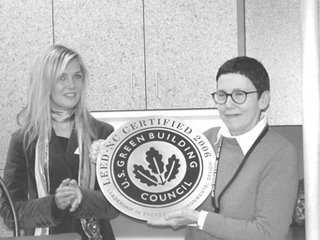 Caption: Jill Isola Johnson, LHB Interior Designer and Sharon Murphy, general manger of Whole Foods Co-op.
Caption: Jill Isola Johnson, LHB Interior Designer and Sharon Murphy, general manger of Whole Foods Co-op.Whole Foods Co-op attains LEED (Green) certification
Whole Foods Co-op not only stocks its shelves with healthy, organic food, its building is good for people and the environment also.
Whole Foods Co-op attained certification by the United States Green Building Councils’ Leadership in Energy and Environmental Design (LEED) It is the first LEED certified building in Duluth, an the third LEED certified building in the state of Minnesota.
Mayor Bergson spoke at the press conference Wed., Oct. 18, The event was held in the community classroom, which is in the basement of the Whole Foods Co-op. “You could have built in a lot of other places and you could have saved a lot of money,” he told the staff and board of the Whole Foods Co-op about their decision to build a “green building.”
The mayor spoke of other green building ideas planned in Duluth which include buildings at the University of Minnesota, Duluth and the DECC. “All of those projects could make us the leader in ecology. I’m proud to be the mayor of an ecomunicpality,” he said.
A certain number of points had to be attained for certification. Points could be gained from these attributes: reusing the site of a former business versus building new, using salvaged materials and equipment versus discarding them, choosing new materials that are long lasting and regional, using galvanized and stainless steel inside and outside, which is long-lasting and requires minimal maintenance, using recycled fiber cement board, rather than strictly plywood, using sheet flooring and countertops made of linoleum, which is made of natural raw materials, using cabinets made of wheat board ,a and annually renewable agricultural material, and using recycled ceramic tile.
After the presentation of the LEED seal (or certificate) the Hillsider toured the Co-op with manager Sharon Murphy and Common Ground representative Jodi Slick. Highlights of this tour included: beams of wood in the entrance were taken from the bottom of the harbor at Ashland, Wisc., flooring which was made of recycled rubber tires, windows which reflect light off the top of the produce cases, counter tops made from pressed sunflower seeds, linoleum which is made of linseed oil, solar panels, tables in the eating room made of old money, special refrigerated case (with no doors which suck the cold air out when opened and can be stocked in the back), and a retaining wall for the hill. The Co-op shares its parking lot with another co-op, the Members Cooperative Credit Union.The offices of the Co-op are in the basement. It includes bike racks for employees to hang up their bikes, a shower and a copier in it own separate room to reduce VOC (Volatile Organic Chemicals.)
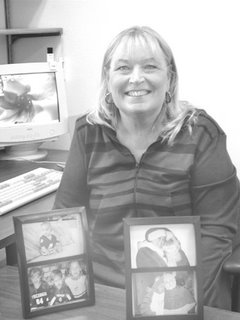
Caption:
Debbie Isabell Nelson at her office at NHS
Isabell Nelson will implement neighborhood revitalziation plans and community outreach at NHS
Debbie Isabell Nelson has been hired as Neighborhood Coordinator at Neighborhood Housing of Duluth, 224 E. 4th St. Debbie will be responsible for overseeing the implementation of neighborhood revitalization plans and community outreach.
Debbie has lived in Duluth all her life. She grew up in Lincoln Park and is a 29 year resident of Morgan Park. Forty years ago, at age 13, she was the president of a Harrison Community Club’s teen board, so community activism has always been an important part of her life.
Debbie will work with neighborhood groups to help communities identify what is needed to revitalize. She said actual residents of communities are best suited to help identify what changes are needed in a community, but often don’t know where to start. Other organizations are helpful in star up of revitalization. Nelson said, “I believe in renovating. Duluth’s housing stock is beautiful. We need to maintain the history of the neighborhood.” Nelson has also volunteered on the Duluth Comprehensive plan.
In some neighborhoods form letters are sent out to residents and landlords of problem properties. Nelson is hoping that this action can be used in other neighborhoods also.
Nelson is working with the community clubs to spur residents and send a message to the city that community policing needs to be fully funded. (See previous entry in the blog.)
Nelson owned and operated Debbie’s Day Care in Morgan Park from 1983 to 2003. She cared for over 170 children during her tenure, while raising her two sons as a single parent. She is a 1970 graduate of Denfield High School.
Earlier this year members of the Morgan Park Community Club nominated her for the Duluth Hall of Fame award. Even though she didn’t receive the award, she was honored by the nomination. Here are two excerpted paragraphs from the nomination letter.
Anyone who knows Debbie and has spent any time around her knows some of her history—taking on and beating the city about her sewage floods, being a catalyst in the city’s decision to move ahead with the MP sewer project AND to keep it funded with CDBG dollars.—her leadership in bringing together diverse groups in pursuit of consensus for the Beautification Project, her creativity in getting all of the age groups in Morgan Park, the seniors, the family people and the youth (especially the youth) involved in this project. Add to that the building of bridges and encouraging cooperation between the homeowners, landlords and renters, and her enthusiasm comes shining through.
The other thing that comes through so very clearly is her ability to visualize and conceptualize what the future should look like, and probably MOST importantly the ability to communicate that vision to the people around her, as well as making them believe in that vision and wanting to make the changes it will take.
Nelson’s family includes her husband Carl, two sons and daughter-in-laws - Peter & Diane and Joshua & Maureen, 3 step kids - Kate, Eric & Scott, along with 4 grandchildren, Ali, Lydia, AJ and Karou, with one more due in October. Visit the Neighborhood Housing Services website at www.nhsduluth.org or phone them at 218-727-8604.
As a group of concerned citizens from across the City we have decided to send a loud, clear, broadbased message to our Administration that we believe in the power of Community Policing, and we want to see it fully funded and fully staffed. You can help!
Please mark your calendar: to do the following on these dates - November 1, 2 & 3: Write a letter to the editor, send an email, or make a phone call to the contacts below. Tell them why you believe in the power of Community Policing to help combat crime in our neighborhoods. On Monday November 6 at 7:00: Attend the City Council meeting to voice your support. City Hall room 330. On Tuesday, November 14 at 6:30: Attend the CIty Wide Meeting on Crime at Holy Family Parish,2430 W 3rd St..
Send Emails to:council@ci.duluth.mn.us - Your email will go to the Mayor & Councilors. City Clerk's Phone the city clerk’s office at 730-5740, or send individual messages to Councilors using first initial, last name & ci.duluth.mn.us EX: ggilbert@ci.duluth.mn.us Also contact mayor and the acting police of chief- hbergson@ci.duluth.mn.us Mayor Herb Bergson 730-5230 and thanson@ci.duluth.mn.us Acting Police Chief Tim Hanson
Letters to Mayor & Council: Letters will be copied & distributed
Duluth City Council, 330 City Hall
411 West 1st Street
Duluth, MN 55802
Letters to the Editor - DNT More info below
letters@duluthnews.com
Thanks for your help!!
Debbie Isabell Nelson Mona Cheslak
NHS Duluth (h) 724-1193
727-8604 ext 12
Cell: 260-8045
On behalf of Community Leaders from across our City!
If everyone of us does one thing...and encourages those in our neighborhoods to do one thing.... We can make a huge impact on the whole City of Duluth!!
Send letter to Duluth News Tribune welcomes letters from readers. Send us your views:424 W. First St.Duluth, MN 55802 Fax: 218-720-4120E-mail: letters@duluthnews.comPlease include your name, address and phone number so we may contact you to verify your letter. Only your name and city will be published. Letters should be 300 words or less and exclusive to the News Tribune. We also will consider exclusive Local View columns of up to 750 words. The columns must reflect greater knowledge of the subject than letters. We edit letters and columns for newspaper style, space, accuracy and civility. To allow a variety of letter writers to appear, no individual may be published more than once every 30 days.

Abondoned property expert shares some solutions with Duluth


No one person really knows how many abandoned properties are in Duluth. Joe Schilling guesses that there are about 2,000 abandoned and vacant properties in Duluth. “The good news,” he said, “Is that they are scattered. What is really great is that you are talking about this issue now.” Schilling is a Professor in Practice at Virginia Tech’s Metropolitan Institute and Director of Research and Policy for the National Vacant Properties Campaign.
If governmental departments share information with each other, Duluth has a good chance of stopping the spread of vacant and abandoned properties into whole blocks. “It is really critical to get the information. Information is power,” said Schilling.
Schilling spoke to a group of concerned Duluth residents at the Central Hillside Community Center on Wed., Sept. 27. He and Dan Kildee, also of the National Vacant Properties Campaign, had spent the day before touring Duluth with Ben Small and Kim Crawford of CHUM Gabriel Project, an initiative to work on issues of poverty.
Schilling and Kildee met with Duluth LISC (Local Initiative Support Corporation), the City of Duluth, St. Louis County, Churches United in Ministry, the Housing and Redevelopment Authority of Duluth, Northern Communities Land Trust, and other nonprofit partners and neighborhood residents to develop effective solutions to the problems of property abandonment. Kildee is the treasurer of Genesee County (Michigan). Flint is a city in Genesee County, which lost 80,000 people. There are blocks of abandoned houses. Duluth does not have a situation as bad.
Schilling said that Duluth was on the cusp of turning worse or getting better. He felt that Duluth had the ingredients to turn the abandoned housing situation around and was in a better position than some of the other cities he has worked with. Those cities include: Philadelphia, Pa, Flint, Mich., San Diego, Calif., and Tucson, Ariz. and Louisville, Ky.
Schilling listed five essential ingredients needed to fight the spread of abandoned property: community catalysts and urban pioneers, leadership and vision, variety of strategies and tolls, systematic program management and convergence and coming together. He told the group of about 15 community members at the meeting, “Congratulations! You guys are doing wonderful work.” He went on to say, “We’ve been really impressed.”
Schilling showed the group a slide show, which explained the continuum from green to brown of vacant properties. Brownfield’s are industrial areas, which have been abandoned due to environmental pollution. Greyfields are business districts, like shopping malls, which have been abandoned.
The broken window theory is one of the main reasons why communities want to prevent abandoned property. Once an area is known as abandoned, windows become broken and it becomes a haven for crime and drugs, fire and a public hazard.
If communities have a policy in place to deal with abandoned property, then when a vacant property pops up, the staff of a city or governmental department knows how to deal with it. Sometimes different departments may be aware that a building is abandoned, but there is no communicating between the departments. For example, the water department may be aware that no water has been used, the city assessor’s office knows that the taxes haven’t been paid in years, and the police or fire department have been dealing with the building, but no one agency has taken the initiative to do anything about it because they are not sharing information together.
Some cities have started ecology and housing courts. For example, two days a week judges who are used to dealing with abandoned and vacant properties listen to cases. The fees from the civil penalties are paid to the city, which can in turn use them to fund prevention programs.
Action steps Schilling suggested included: adopting and administrating a rental inspection, registration of vacant property ordinance, creating a vacant property coordinator, education and training on how to be a better landlord, and reform of existing building and zoning codes.” You don’t need to go to St. Paul,” he said, referring that cities in Minnesota have the power to enact their own codes.
An effective method in some towns has been a “shaming sign.” A huge sign is posted on the vacant property listing the owner of the property and the code violations. Sometimes the press is called as the sign is being posted. Schilling said the shaming signs have been effective. Within few days of the signs’ posting, the violations have been remedied. There are other ways of shaming people. He talked of a doctor who owned abandoned properties, people stood on the sidewalk in front of his practice and said, “Dr. Jones is a slumlord here is a photo of his property.”
In a separate interview, Pam Kramer, Senior Program Director of Duluth LISC said, “What I am excited about is the opportunity to work together on a comprehensive approach. I was very impressed with the level of commitment (by governmental officials) to work on the issue of blighted property and vacant land.
(Duluth LISC secured $15,000 in federal Department of Housing and Urban Development funds from national LISC to provide technical assistance to address this issue. In addition to this technical assistance visit, a series of “virtual brown bag” training sessions and other consultation will be provided. The National Vacant Properties Campaign is a collaboration of four leading national organizations: Smart Growth America, Local Initiatives Support Corporation, the International City/County Management Association, and the Metropolitan Institute at Virginia Tech.)

Caption: Teens have fun at the Encounter
The Skate Park is open this fall five days a week. It’s the only indoor skate park in the area with a large variety of ramps, rails, stairs and boxes. Skaters from all backgrounds and abilities have the opportunity to improve their skills, learn new tricks, or try the sport for the very first time in a fun, safe and active environment.
The Red Room as one of the last pieces of the Encounter’s ministry puzzle provides us with yet another tool to reach a completely different sub-culture of young people. The Red Room is unique in that it is one of our areas only music venues that caters to young people. We have many local bands that have begun to perform at the Red Room & love it. Open mic, a pool table and coffee bar are also available for some extra fun. The Red Room is quickly becoming the place to be for music lovers!
In addition, the Red Room will be home to our popular Girls Night. Thursday nights from 6-9 p.m., girls of all ages are invited to come and participate in activities just for girls. Such as - hanging out, long talks, baking, nature walks, movie nights, open mic nights, and of course-manicures!
One of the programs we are most excited about this year is the return of junior and senior high school open gym nights. On Friday and Saturday evenings youth are welcome to come and join in on a variety of gym sports. Basketball, volleyball, dodge ball, and floor hockey are just some of the activities. Sunday night in the gym will host a complementary program to our very popular skate church. “Half Time” will run every Sunday night from 4-8 p.m.. It will be a free night of sports, food and of course a great message for the participants.
Here are some additional ministries at the Encounter’s this year:
Drama Night- every Tuesday night those with or without dramatic experience are welcome to learn the skill of improvisation comedy.
Night Life - our college age program will meet on Thursday nights this year. Anyone 18 and over is encouraged to participate in this evening, complete with at least one themed athletic activity.
Snowboard in the City- This is a new program that will start this winter at the Encounter. Snow-boarders of all ages will be able to snowboard at a variety of places in the city, including riding the hill right outside of the Encounter.
Youth Church – A once a month opportunity for youth to gather together to praise God together with others their own age. They will have experience a worship setting geared specifically to them. Also, there will be a message of hope that is sure to inspire.
Noon Ball- Noon basketball returns as a time for area guys to come and play some ball.
Quest- Two discipleship programs which originated at the Encounter Many youth from around the area are visiting the Encounter daily, because whatever the interest is, we definitely have a program to explore and grow that interest. Moreover, there are many welcoming staff members who are building lasting mentorships and friendships with our youth every day.
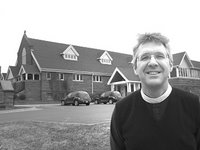 Rev. Robert C. Franck to be installed as
Rev. Robert C. Franck to be installed as Senior Pastor at Mr. Olive Lutheran Church on Nov. 12
Pastor Franck has served Mount Olive and local colleges and universities for the past 11 ½ years as Associate and Campus Pastor, a position that is being phased out while LCMS campus ministry in Duluth is being restructured. The Senior Pastor position will include a 10% commitment to campus ministry. Other support for campus ministry is being investigated.
The Hillside's Hidden Streams: Brewery Creek

A story told to and recorded by Nancy Nelson
I am Brewery Creek. I’ve lived on Duluth’s hillside for thousands of years, a lot longer than any of you folks have been here. I’ve carried lots of water down the hill to Lake Superior, and I’ve seen lots of changes over the years.
My territory includes a little more than a square mile. My western branch starts up by Central Entrance, in a little wetland behind Taco John’s. I flow past the Marshall School, where my smaller eastern branch joins in. After I cross under Rice Lake Road by the MNDOT office the real fun begins as I race down the steepest part of the hill. The street you call Sixth Avenue East used to be my ravine. These days I disappear from view near the UDAC building, but you can see me again at the lakeshore just below Sir Ben’s.
I had this place pretty much to myself for a long time, flowing free all the way from the heights to Lake Superior. Then around 150 years ago people started cutting down trees, making streets, and putting up buildings all over the hillside.
For a while these folks found me useful. Back in about 1859 Duluth’s first brewery was built on my western bank between Seventh and Eighth Avenue East, just above what is now the “freeway.” The brewery used my water for making beer, so folks started calling me Brewery Creek.
About 20 years later, there was a big rain storm, and I had to move a lot of water down the hill really fast. I was just doing my job, but I got a little carried away and washed out a piece of the hill under the brewery. Part of the building fell down and lots of beer got spilled. Mr. Fink, who ran the brewery, wasn’t very happy about it, so he decided to build a new place down on the lakeshore. He sold that building a few years later to two men – Mr. Fitger and Mr. Anneke. I hear they still make beer there, although they don’t use my water anymore.
Back in those days nobody had cars. Most things were moved around in carriages that were pulled by horses and mules. It was pretty hard for them to cross me, so bridges were built on some of the streets. As I remember it, there was a bridge on East Sixth Street and another one on East Tenth Street. I didn’t mind the bridges because I could still see the daylight and talk to all the critters that came to visit me. But from East Fifth Street on down the hill to Superior Street, the engineers decided to cover me up completely so they could just build streets and not worry about bridges. They put me in big brick and concrete tunnels and covered the tunnels with dirt. Goodbye daylight!
It got even worse when people started driving cars. They got annoyed when they couldn’t cross me at the streets that didn’t have bridges. I was in the way of progress, so the engineers kept working. During the early 1900s they built more tunnels, which got longer and longer. Piece by piece, they put me in the tunnels and covered me up. By the end of the 1920s I was in the dark most of the way from Tenth Street to the lake. Eventually the folks living in the hillside forgot all about me because they couldn’t see me. Some folks even built houses and gas stations right on top of me!Well, even though you don’t see me any more, I still do my job of carrying water to Lake Superior.
I have more stories to tell, like all the fun I had in 1972 when three big storms came through the hillside. But I hear there’s some rain coming, so I’d better get back to work now. I’ll tell you more next time!
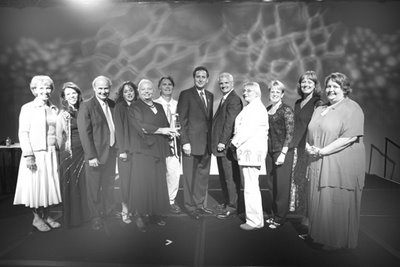
Nettleton Magnet Elementary School was recognized with the prestigious Minnesota’s Future Award for high academic performance by the Minnesota Business Partnership.
Nettleton was the only school chosen for this award in the state of Minnesota. The Minnesota Business Partnership is a nonprofit group of 100 CEO’s leading the state’s largest employers.
Nettleton’s Principal, Stephanie Heilig; Assistant Principal, Kathi Kusch Marshall; and a group of dedicated staff members traveled to Minneapolis to the Minnesota Business Partnership Annual Dinner to accept this important award. The event was attended by many noteworthy Minnesota business leaders, community leaders, local Minneapolis/St. Paul media, and Governor Pawlenty.
The percentage of Nettleton 3rd and 5th graders performing at or above grade level in reading and math from 2003 through 2005 was comparable to the statewide average. Nettleton focuses on reading.
With the help of a “Reading First” grant implemented in partnership with the University of Minnesota, Nettleton teachers learned and embedded effective reading practices into all subjects. Rather than rely on remediation to help struggling readers, Nettleton increased academic rigor and expectations, then provided additional support during and after school for students. “In many ways, we follow the pattern of successful businesses: We know our market, we base or decisions upon the latest research and best practices,” said Nettleton Principal Stephanie Heilig

Neighborhood involvement helps solve crime
Photo captions: Stg. Dan Boese and Information Technician Phyllis Manurich
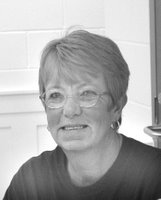
The best way to curtail crime is to be aware of your surroundings. Keep your doors locked, both vehicle doors and outside home doors. And if something makes you feel uncomfortable, phone 911. You have the right to feel at ease in your own home.
This was the advice given to neighbors who attended and East Hillside Neighborhood meeting with the police in September.
One resident of the neighborhood said, “I feel odd calling 911.” Sgt. Dan Boese said, “It is a quality of life issue. If you don’t feel comfortable in your home…call.” He went on to say that the police can sometimes piece events together to solve or curtail crime when the public phones about suspicious activity.
This meeting took place at the Grant Recreation Center, 901 E. Eleventh Street on Tues., Sept. 26. Fourteen community members visited with four police officers and Information Technician, Phyllis Marnuich. The officers included: Lt. Mike Tusken, Sgt. Dan Boese, Sgt. Steve Stracek and Officer Jeremy Graves.
In the past couple of months residents’ homes have been robbed while they were at home with their doors unlocked. Also, if your car is unlocked it is so much easier to steal something out of the car, or search around inside the car for an extra key.
Community members visited with the police and talked about what they could do to ensure cooperation between residents whether they are homeowners or renters. One landlord was present. He spoke of his concern of keeping good tenants.

Lt. Gordon Ramsay talking to neighbors at the Central Hillside Community Center.

A Central Hillside resident asks a question.
Lt. Gordon Ramsay told a group of about 50 neighbors at the Central Hillside Community Center that police and residents will now meet monthly for the next few months. The purpose of the meeting was to see how the police and residents can work together on crime and safety issues in the neighborhood.
Ramsay will also work to implement block clubs. Neighbors would meet with the police to identify problems in their specific blocks. Each block might have unique issues. Junk cars might be an issue for one block, while a gang of rough kids would be an issue for a different block. Police would literally walk around the neighborhood with the residents to identify these concerns.
The block clubs give a formal identity. “It gives a block a little more power with city government,” said Ramsay. Other issues of concern might be lighting, streets, and parking. Block clubs would go beyond just dealing with crime after the fact. It would be taking a proactive stance.
Ramsey told the Central Hillside group that the burglar who was responsible for approximately 30 to 40 robberies this summer, many of them while residents were home, had been arrested and was now in jail.
Central Hillside is constantly fighting an image that it is dangerous, but it is not said Ramsey. He said it is more densely populated and therefore there are more calls of disturbances of the peace. Nationwide robberies were high this summer; Duluth was no different.
As far as personal safety goes, the Central Hillside is no more dangerous than other neighorhood as densely populated. Most violent crime is between people who know each other.
According to Ramsey, James Redd, owner of the Hip Hop Candy Shop, 105 W. 4th St., where shots were fired in October, has closed up his shop and left town. Ramsey said Redd was charged with drug sales and there is a warrant out for his arrest.” We were pleased to see him go, but we would like to find him . . .(and serve the warrant,)” said Ramsay.
“Don’t ever hesitate to call 911,” said Ramsay. “We’d rather find out it is a neighbor house-sitting. …(than something more serious.)” Ramsey said phone calls of suspicious activity are how the police solve crimes, which was the case in catching the burglar responsible for 30 to 40 incidents this summer.
The police are trying to work more closely with the building inspection department and landlords to prevent nuisance properties. Police are working with landlords to help them learn to how do background checks. This is available free of charge through St. Louis County.
Ramsay said a small group is causing problems for the majority of people. Between 5,000 and 10,000 people live in the Central Hillside; and 20,000 work in the Central Hillside. “Our problem people are the same 50 people.” He said that Central Hillside cops get to know these people so well that they know their full names, social security numbers and birth date. The problem is the judicial system puts these people back out on the streets making a revolving door. Criminals are cited and arrested but the consequences are not serious enough to prevent people from committing the crime again. Neighbors who show up at sentences and read victim impact statements are helping to put criminals behind bars.
Next month George Garnett of Neighborhood Housing Services will speak about what the Lincoln Park Neighborhood is doing to crack down on abandoned houses, illegal garbage dumping, and crime and drug activity.Hopefully the Central Hillside neighborhood can learn from Lincoln Park.


